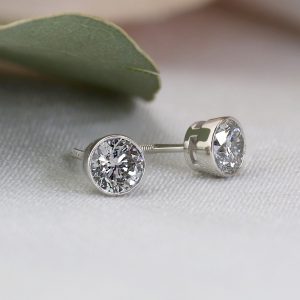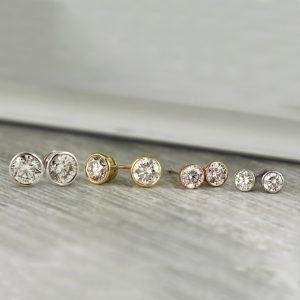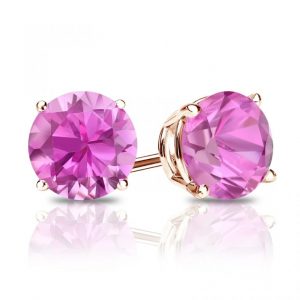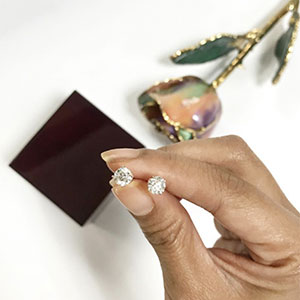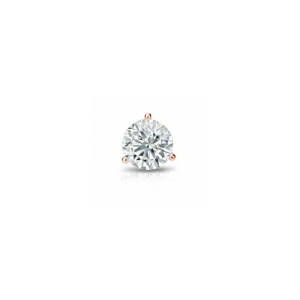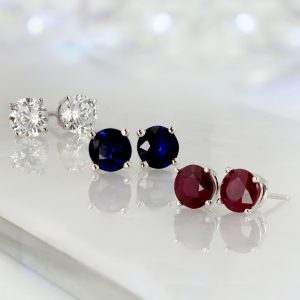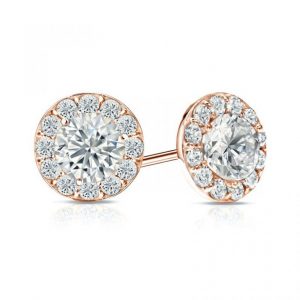
Diamond stud earrings are beautiful and timeless. They’re also incredibly versatile. There are so many different styles of diamond studs. When you shop for diamond studs, you’ll find that you have numerous diamond shapes, diamond settings, and precious metals to choose from. Then, of course, there are thousands of individual diamonds to choose from within each shape category. So how do you buy the best diamond stud earrings? In this post, we’re breaking down everything you need to know about buying diamond studs. We’ll cover how to find the best quality diamonds for your budget and how to choose the perfect diamond studs for your unique style.
Diamond Quality and Buying Diamond Stud Earrings

First, let’s talk diamond quality. Most people have heard of the Four Cs of diamonds: cut, color, clarity, and carat. It’s important to understand how these four qualities can impact any diamond. But there are some special considerations for diamond studs. The good news is that these special considerations mean you can often go a bit lower in quality grade for color and clarity.
When you wear diamond stud earrings, people will almost always view them from a distance. Unlike with a diamond engagement ring, people will rarely inspect your diamond studs up close. This means that you can be a little more relaxed with quality if your budget requires it, while still getting diamonds that look gorgeous in your jewelry.
Diamond Clarity and Diamond Studs
Clarity is one quality you can go a bit lower with for diamond earrings. Clarity is a measurement of how flawless a diamond is. Higher clarity diamonds will have fewer inclusion and blemishes, while lower clarity diamonds have more. Since diamond studs are viewed from a distance, tiny inclusions are blemishes are hard to spot. Additionally, diamond studs are less of a high pressure purchase than something like an engagement ring. So many people are less bothered by the presence of minor flaws in their studs’ diamonds.
If you’d like a specific recommendation for clarity and diamond studs, the GIA has one. The jewelry experts at the GIA suggest that you can go as low as SI1, SI2, I1 or even I2 for diamond studs.
Diamond Color and Diamond Studs
Color is another quality you can usually go lower with for diamond stud earrings. Diamonds tend to pick up the color of what surrounds them. This means that diamond studs will reflect the color of your skin and hair, affecting the perceived color your studs’ diamonds. Because of this, many people find that diamonds lower on the D to Z color grade scale look just as beautiful as colorless diamonds in diamond studs. For the best value, we would recommend selecting diamonds within the H to K color range.
Diamond Cut and Diamond Studs
While you can get away with going lower in color and clarity for diamond studs, diamond cut is one thing you shouldn’t sacrifice on. As we mentioned before, diamond studs are generally viewed from a distance. This makes diamond cut, the measurement of how well a diamond was cut, even more important. If you want your studs to sparkle from a distance, you’ll want to choose diamonds that are well cut.
So, with all that said, our recommended cut grade range for diamond earrings is the same one we would recommend for an engagement ring. If you want a diamond that sparkles beautifully, go with a cut grade of Very Good or Excellent.
Diamond Carat and Diamond Studs
Diamond carat is a weight measurement that can give you an idea of how large a diamond is. Most people want to buy the largest carat weight diamonds that fit within their budget. So we don’t have any specific recommendations here. However, we do have an important tip.
When you buy diamond studs, you’re buying a pair of diamonds. Generally, the carat weight of diamond studs is listed with the abbreviation “ctw,” which stands for “carat total weight.” This means that the carat weight listed for the diamond studs is the combined total weight of both diamonds. For example, a pair of diamond studs with a 1 ctw will feature two 0.50 carat diamonds. Keep this in mind as you shop for diamond studs so you don’t accidentally buy diamonds that are half the size you wanted.
Earring Styles and Buying Diamond Stud Earrings
Now, let’s talk about the fun part of buying diamond studs: style! Your diamonds’ shape, setting style, and your choice of precious metal will all impact your studs’ style. Let’s take a closer look at how to choose a style you’ll love.
Diamond Shapes and Diamond Stud Style

The shape of your diamonds has perhaps the biggest impact on the style of your diamond studs. The most popular shapes for diamond studs are round, princess, and cushion cut. If you’re not sure which shape has the style that’s right for you, browse our style notes below.
Round: Round diamonds have a classic, traditional look and exceptionally high brilliance.
Princess: Princess cut diamonds have a clean, modern look.
Cushion: Cushion cut diamonds have a romantic, vintage look.
Asscher: Asscher cut diamonds are angular and geometric, with an Art Deco Era vintage style.
Emerald: Emerald cut diamonds are chic and glamorous, with a Retro Era vintage style.
Marquise: Marquise cut diamonds are elegant and incredibly unique.
Oval: Oval cut diamonds are sophisticated, timeless, and distinctive.
Pear: Pear shaped diamonds are graceful and highly unique.
Setting Styles for Diamond Studs
Diamond studs can be held in a number of different settings. Each of these settings can switch up the style of your studs. The most popular settings for diamond studs are prong settings, bezel settings, and halo settings. Four prong settings have the most classic, traditional look. Bezel settings have a sleek, contemporary style. Then, halo settings are highly glamorous.
Precious Metals and Diamond Stud Style
Your choice of precious metal will also impact the style of your studs. Many people already have a precious metal preference for jewelry in general. But if you’re not sure which precious metal would be right for you, you can choose based on the style of the precious metal. Or, you can choose based on which precious metal would work best with your skin undertone.
Diamond stud settings are usually made from one of four precious metals: platinum, white gold, yellow gold, or rose gold. Platinum and white gold have similar, bright white look. These two metals are chic and elegant. Both platinum and white gold have cool undertones, which means they look lovely on those with cool skin undertones. Then, there’s yellow gold. Yellow gold is classic and highly traditional. Yellow gold has warm undertones, so it works well for those with warm skin undertones. Lastly, we have rose gold. Rose gold is highly romantic and has a vintage look. Rose gold has a neutral undertone, so it’s highly complementary on those with neutral skin undertones.
If you want a white precious metal, you may be wondering which you should choose: white gold or platinum. White gold is more affordable than platinum, so it’s a good option for those who want to maximize their budget. However, platinum is hypoallergenic. So if you have any metal allergies, you may want to spend a bit more and get platinum settings.
Earring Backs and Diamond Studs
Finally, let’s talk about earring backs. Earring backs are not visible when you wear diamond studs. But they can have a big impact on how comfortable or secure your earrings are. At Diamond Studs, we offer three different earring back styles: push backs, screw backs, and secure lock backs. Push backs are the most common earring back style. This style pushes into place. Screw backs offer a bit more security, as they screw into place. Then, secure lock backs firmly lock into place, offering the highest level of security. Our secure lock backs also have a wider back, which allows larger diamond studs to rest more comfortably on the ear.
Your choice of earring back all comes down to personal preference. At Diamond Studs, you can customize your earring back style to select the level of comfort and security that’s right for you.
A Note on Certification
To close out our guide on how to buy the best diamond stud earrings, we have a note on certification. Whenever you buy a diamond, you should always make sure it comes with a grading report from a reputable diamond grading lab. A grading report gives you a record of what you are buying. It also gives you extra assurance that you’re getting a real diamond with verified qualities.
At Diamond Studs, all of our diamonds come with a grading report from either the GIA or EGL USA, two of the most respected grading labs in the world. If you have a preference between these two labs, our Diamond Stud Finder has a feature that allows you to sort diamonds by grading lab.







 1-855-969-7883
1-855-969-7883 info@diamondstuds.com
info@diamondstuds.com



